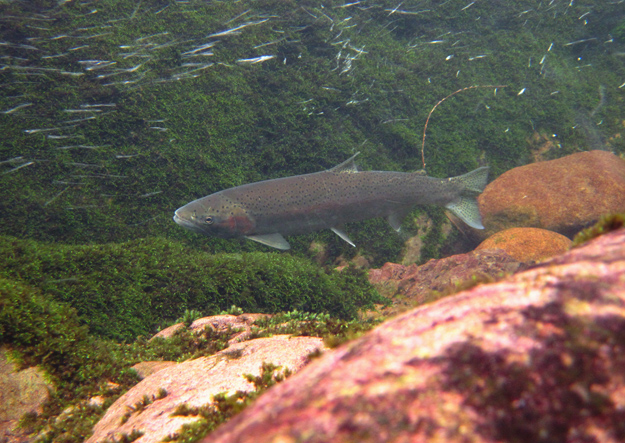
Upper Willamette wild steelhead has been listed as “threatened” under the federal Endangerd Species Act since March 1999. Oregon fisheries has not allowed a harvest of these fish for more than 20 years. California sea lion populations are robust, and the animals are not listed under the Endangered Species Act but are protected under the federal Marine Mammal Protection Act. They are mauling the trout population. Photo NOAA Fisheries West Coast Region.
Willamette Steelhead on Verge of Extinction
August 7, 2017 / Bend, Oregon / MyCentralOregon.com
[dropcap]O[/dropcap]ne of Oregon and the Pacific Northwest’s iconic fish, native steelhead trout, have been migrating over Willamette Falls in Portland to spawn in Cascade Mountain rivers for millennia. They are now at high risk of going extinct, based on a new analysis by Oregon Department of Fish and Wildlife.
Listed for protection under the federal Endangered Species Act (ESA) in 1999 due primarily to the impacts of federal dams and habitat loss, wild native Willamette steelhead has now slipped to high risk of extinction. Willamette steelhead now faces a new and growing threat from male sea lions that have learned to exploit the fish as they congregate below Willamette Falls before navigating upriver to spawn.
Continuing a decade-long downward trend, the number of wild steelheads returning to the upper Willamette this year was the lowest on record, with only 512 fish passing above the Willamette Falls. ODFW scientists found that sea lions consumed at least one-quarter of the wild steelhead run and warned that if sea lion predation continues at these levels, there is an up to 90 percent probability that at least one wild steelhead population will go extinct as a direct result of the predation. The near-term risk of wild steelhead extinction can be significantly reduced or avoided by limiting sea lion access to Willamette Falls.
“We know what the problem is and have seen this coming for about a decade, we just couldn’t take action to prevent it,” said Dr. Shaun Clements from ODFW.
California sea lions have expanded along the West Coast over the past four decades to a population of nearly 300,000 animals coast-wide today. As numbers increased, a small proportion of sea lions – all males – have expanded their range into freshwater areas where migrating salmon and steelhead are especially vulnerable, including in places such as Ballard Locks in Washington, Bonneville Dam, and at the Willamette Falls, where fish tend to congregate before moving upstream. At these locations, predation by sea lions is especially high and adversely impacts salmon, steelhead, and sturgeon. In the 1980s, sea lion predation on winter steelhead at Ballard Locks in Seattle effectively destroyed the Lake Washington stock.
“Removal of a few problem individuals will have no impact on the overall sea lion population but can significantly benefit ESA-listed fish,” said Robin Brown, lead scientist for ODFW’s marine mammal program.
Any solution to address the threats to wild fish populations will have to strike a balance between the recovery of imperiled salmon and steelhead populations and the ongoing conservation of sea lions. Also at stake are significant regional investments in recovery efforts, such as . . . Read the complete story






